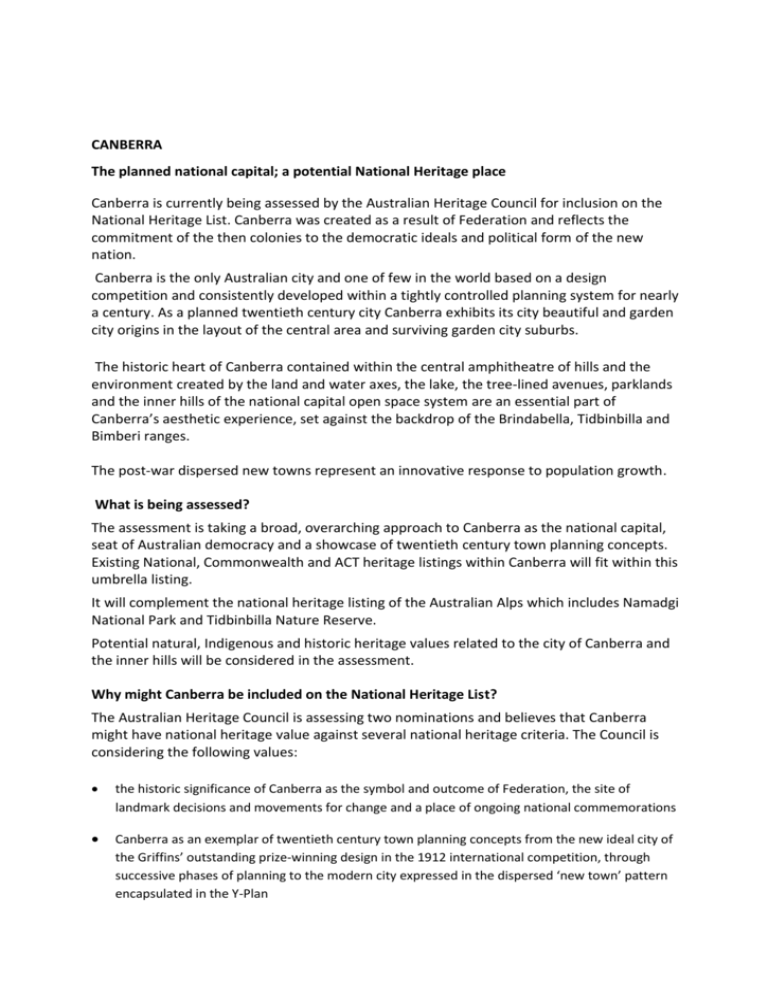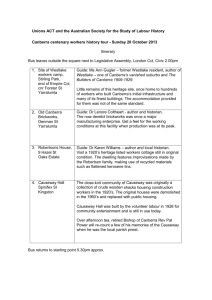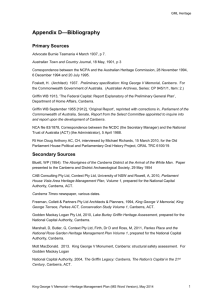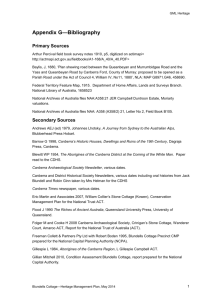a potential National Heritage place (June 2012) (DOCX
advertisement

CANBERRA The planned national capital; a potential National Heritage place Canberra is currently being assessed by the Australian Heritage Council for inclusion on the National Heritage List. Canberra was created as a result of Federation and reflects the commitment of the then colonies to the democratic ideals and political form of the new nation. Canberra is the only Australian city and one of few in the world based on a design competition and consistently developed within a tightly controlled planning system for nearly a century. As a planned twentieth century city Canberra exhibits its city beautiful and garden city origins in the layout of the central area and surviving garden city suburbs. The historic heart of Canberra contained within the central amphitheatre of hills and the environment created by the land and water axes, the lake, the tree-lined avenues, parklands and the inner hills of the national capital open space system are an essential part of Canberra’s aesthetic experience, set against the backdrop of the Brindabella, Tidbinbilla and Bimberi ranges. The post-war dispersed new towns represent an innovative response to population growth. What is being assessed? The assessment is taking a broad, overarching approach to Canberra as the national capital, seat of Australian democracy and a showcase of twentieth century town planning concepts. Existing National, Commonwealth and ACT heritage listings within Canberra will fit within this umbrella listing. It will complement the national heritage listing of the Australian Alps which includes Namadgi National Park and Tidbinbilla Nature Reserve. Potential natural, Indigenous and historic heritage values related to the city of Canberra and the inner hills will be considered in the assessment. Why might Canberra be included on the National Heritage List? The Australian Heritage Council is assessing two nominations and believes that Canberra might have national heritage value against several national heritage criteria. The Council is considering the following values: the historic significance of Canberra as the symbol and outcome of Federation, the site of landmark decisions and movements for change and a place of ongoing national commemorations Canberra as an exemplar of twentieth century town planning concepts from the new ideal city of the Griffins’ outstanding prize-winning design in the 1912 international competition, through successive phases of planning to the modern city expressed in the dispersed ‘new town’ pattern encapsulated in the Y-Plan rarity as the only Australian major city consistently subject to centralised planning controls for nearly a century and in which successive trends in twentieth century international city planning can be clearly read the aesthetic appeal of the designed landscapes that showcase the national capital and the natural hill and mountain settings of the city, which are highly valued by the Canberra community and visitors for its beauty, garden city appeal and national symbolic content creative and technical achievement in the fields of town planning, urban design and landscape architecture social significance associated with landmark Indigenous rights decisions or protest sites and places of national commemoration Canberra’s association with governors-general and prime ministers, politicians whose election marked milestones in the evolution of Australian democracy, and the people who played a significant role in the planning and development of Canberra. What is the proposed National Heritage ‘place’? The proposed national heritage listing might include: the central historic area of Canberra including the Parliamentary Triangle, the land and water axes and Lake Burley Griffin and surrounding parklands the surviving street pattern set out in the 1918 Griffin Plan and within the early garden suburbs of the 1925 Gazetted Plan the planning concept of the Y-Plan ‘new towns’ connected by arterial roads and the location of the town centres. (No specific town centre layout, buildings or road alignments are included, nor any residential land at or near town centres) the undeveloped inner hills of the national capital open space system. The proposed listing only includes places within public ownership. The backdrop of mountain ranges that form part of Canberra’s aesthetic setting are not included in the proposed boundary but key views and vistas from the central area towards the ranges will be recognised. What is the proposed listing boundary? The proposed boundary of Canberra is shown on a map that can be downloaded from the Council’s website at www.environment.gov.au/ heritage/ahc/national-assessments/canberra The whole area coloured in light green with a pink border is included in the place proposed for national heritage listing. A similar pink boundary runs along either side of the nature strip along the marked roads of the early garden suburbs, enclosing the verges and tree plantings as well as the road alignments in the proposed place. No private land or buildings are included within the boundary. The town centre symbols represent the locations of the town centres as a planning concept but do not include a particular street layout or collection of buildings. Note that the arterial 2 roads connecting the town centres are not mapped because the proposed place boundary does not include particular road alignments. Will my house or business be affected? No, your home or business will not be affected by the proposed listing. Draft national heritage values only reside with land/property in public ownership. Residential and commercial properties are excluded from the proposed national heritage values. How can I be involved? Consultations with owners, occupiers, land managers and Indigenous people with rights or interests have commenced in accordance with the Environment Protection and Biodiversity Conservation Act 1999. An information paper will be available on the Australian Heritage Council’s website at www.environment.gov.au/ heritage/ahc/national-assessments/canberra to provide more detailed information. What is the next step? Following consultation, the Council will give its final assessment report, including proposed national heritage values, to the Minister for Sustainability, Environment, Water, Population and Communities. The minister will decide whether to include the place on the National Heritage List. When will the Council complete its assessment? The Council is aiming to complete its assessment in time for a possible inclusion in the National Heritage List to coincide with the centenary of Canberra in early 2013. 3






